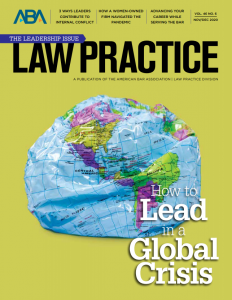 A favorite business development endeavor for many lawyers (me included) is involvement on a nonprofit board. It can be time-consuming, potentially expensive and sometimes frustrating, but it is a do-good activity that ideally is tied to an area of interest and passion. In my November/December 2020 marketing column in Law Practice, I write on Profiting from Nonprofit Board Involvement.
A favorite business development endeavor for many lawyers (me included) is involvement on a nonprofit board. It can be time-consuming, potentially expensive and sometimes frustrating, but it is a do-good activity that ideally is tied to an area of interest and passion. In my November/December 2020 marketing column in Law Practice, I write on Profiting from Nonprofit Board Involvement.
The heart of my column comes from conversations with leaders of BoardAssist, a nonprofit itself that matches prospective board members with nonprofits in the New York metropolitan area (including New Jersey and Connecticut). Cynthia Remec, the executive director and founder of BoardAssist, is a former attorney who started her career at Pillsbury Winthrop and Weil Gotshal. I also received valuable input from Richard Hall, a partner at Cravath, Swaine & Moore, and a longtime member of its board of directors.
Like many aspects of our lives, nonprofits are reeling in the midst of a pandemic where time, money and resources are hard to come by. For board members, there is the teeny, tiny silver lining of being able to conduct most of these meetings from the comfort of home. However, that in-person human interaction is lost. And I’ve heard a number of people lament that they miss the free snacks at meetings. I, myself, will trade sitting at home in sweats and buying a box of munchkins out of pocket. But, seriously, it is true that removing the travel element (sometimes involving getting on a plane) can make donating your time simpler and easier. Bottom line—nonprofits need us to step up now, more than ever.
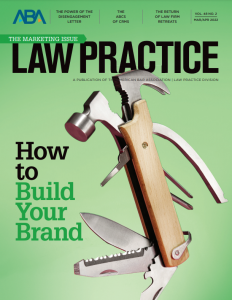 In that brief time snugly between delta and omicron, I had the opportunity to speak at a law firm retreat. Live. In-Person. With people. No masks. In a hotel. Food served. It was circa 2019 and it was so nice to put on a suit and close the Zoom app. In the March/April 2022 issue of Law Practice, I discuss The Return of Law Firm Retreats.
In that brief time snugly between delta and omicron, I had the opportunity to speak at a law firm retreat. Live. In-Person. With people. No masks. In a hotel. Food served. It was circa 2019 and it was so nice to put on a suit and close the Zoom app. In the March/April 2022 issue of Law Practice, I discuss The Return of Law Firm Retreats.



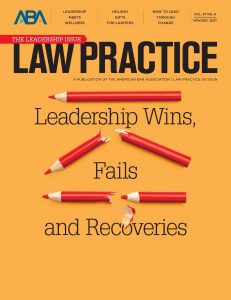 The third annual Up-Down Drill, which played off my favorite morning-after column in The Philadelphia Inquirer after an Eagles game (why did Jeff McLane stop doing it?), was one of the more difficult to write. In the November/December 2021 issue of Law Practice,
The third annual Up-Down Drill, which played off my favorite morning-after column in The Philadelphia Inquirer after an Eagles game (why did Jeff McLane stop doing it?), was one of the more difficult to write. In the November/December 2021 issue of Law Practice, 
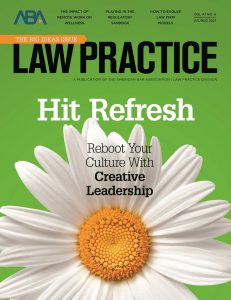 Yes, I went with the lowest hanging fruit of topics for my marketing column in the July/August 2021 issue of Law Practice,
Yes, I went with the lowest hanging fruit of topics for my marketing column in the July/August 2021 issue of Law Practice, 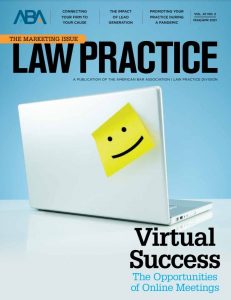 Earlier this week, I read an interesting article about how business travel will never fully return, because you can just go on Zoom, saving a ton of time and money. The story and premise all made sense until a quote at the end saying that the first time someone lost a sales pitch to a competitor that presented in-person—they’ll be right back on those airplanes. And I shook my head knowing that was so true.
Earlier this week, I read an interesting article about how business travel will never fully return, because you can just go on Zoom, saving a ton of time and money. The story and premise all made sense until a quote at the end saying that the first time someone lost a sales pitch to a competitor that presented in-person—they’ll be right back on those airplanes. And I shook my head knowing that was so true. This is the time of year where I sit down with my marketing committees to review what successes we had with our 2020 marketing plan and budget. The same for many one on one discussions with individual attorneys on his/her business development plans. Well, I’m not taking the blame for any failures this year—just say “COVID” and try again. So in this month’s issue of the ABA’s
This is the time of year where I sit down with my marketing committees to review what successes we had with our 2020 marketing plan and budget. The same for many one on one discussions with individual attorneys on his/her business development plans. Well, I’m not taking the blame for any failures this year—just say “COVID” and try again. So in this month’s issue of the ABA’s  If you want to read a powerful piece about the hottest topic in law firm marketing circles this year, the lead feature in the December 2020 edition of the
If you want to read a powerful piece about the hottest topic in law firm marketing circles this year, the lead feature in the December 2020 edition of the 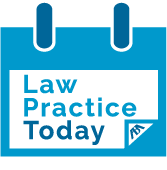
 A favorite business development endeavor for many lawyers (me included) is involvement on a nonprofit board. It can be time-consuming, potentially expensive and sometimes frustrating, but it is a do-good activity that ideally is tied to an area of interest and passion. In my November/December 2020 marketing column in Law Practice, I write on
A favorite business development endeavor for many lawyers (me included) is involvement on a nonprofit board. It can be time-consuming, potentially expensive and sometimes frustrating, but it is a do-good activity that ideally is tied to an area of interest and passion. In my November/December 2020 marketing column in Law Practice, I write on 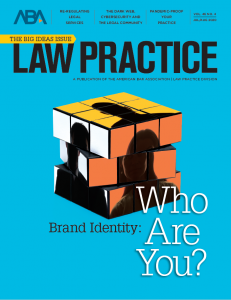 My annual
My annual